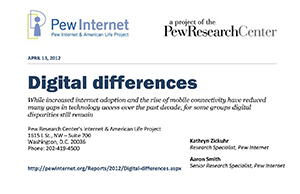While increased internet adoption and the rise of mobile connectivity have reduced many gaps in technology access over the past decade, for some groups digital disparities still remain
When the Pew Internet Project first began writing about the role of the internet in American life in 2000, there were stark differences between those who were using the internet and those who were not.1 Today, differences in internet access still exist among different demographic groups, especially when it comes to access to high-speed broadband at home. Among the main findings about the state of digital access:
- One in five American adults does not use the internet. Senior citizens, those who prefer to take our interviews in Spanish rather than English, adults with less than a high school education, and those living in households earning less than $30,000 per year are the least likely adults to have internet access.
- Among adults who do not use the internet, almost half have told us that the main reason they don’t go online is because they don’t think the internet is relevant to them. Most have never used the internet before, and don’t have anyone in their household who does. About one in five say that they do know enough about technology to start using the internet on their own, and only one in ten told us that they were interested in using the internet or email in the future.
- The 27% of adults living with disability in the U.S. today are significantly less likely than adults without a disability to go online (54% vs. 81%). Furthermore, 2% of adults have a disability or illness that makes it more difficult or impossible for them to use the internet at all.
- Though overall internet adoption rates have leveled off, adults who are already online are doing more. And even for many of the “core” internet activities we studied, significant differences in use remain, generally related to age, household income, and educational attainment.

